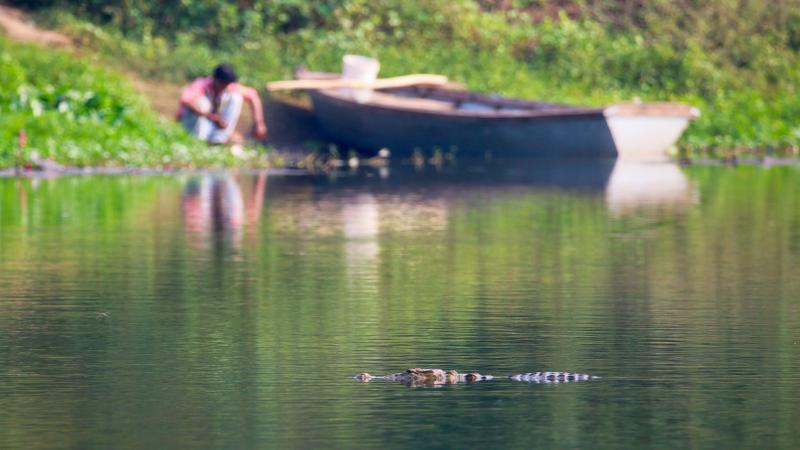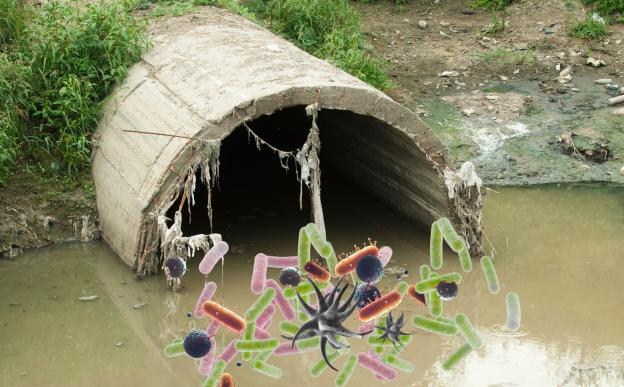
Photo by Rupeshsarkar via Wikimedia Commons
Every year, several Mugger crocodile attacks are reported in Gujarat, claiming several human lives. But its districts have caught media attention, not because of the attacks but due to the positive relationship between the locals and the crocodiles. Communities are known to protect the mugger crocodiles actively and even build them small islands in the village ponds, despite the danger they pose. Researchers Anirudhkumar Vasava from Voluntary Nature Conservancy, Gujarat, and Simon Pooley from Birkbeck University of London, UK, met with the locals to understand how this coexistence came to be. They quickly realised that studying coexistence is no easy task. Observing the challenges, they have explored the need to shift how we think and study human-wildlife relationships in an essay in the journal Conservation Biology.
Travelling around the districts of Kheda, Anand and Vadodara in Gujarat, the researchers interviewed people who had been bitten or were involved in human–crocodile conflicts. The locals often avoided their questions about the crocodile attacks or provided evasive answers. Moreover, communicating and translating their questions often proved to be challenging.
“Human–-wildlife coexistence is academically understudied. Our aim was to initiate a wider dialogue on the necessity and challenges of studying coexistence,” says Dr Saloni Bhatia, a postdoctoral fellow at the Indian Institute of Technology Bombay (IIT Bombay), who was involved in the study.
Indeed, studies have shown that research on human–wildlife relations is skewed towards conflict. A study conducted in 2019 found 71% of the prominent literature on human–wildlife relations focused on conflict, while only 2% concentrated explicitly on coexistence.
The authors explain that conservation research is often based on simply getting the numbers — deaths due to conflict, damage caused to crops and other economic costs. This might enhance our understanding of the effects of human–wildlife conflict, but research conducted in this manner overlooks the more nuanced effects of the conflict, such as the trauma faced by both humans and animals and how it is dealt with in different socio-cultural contexts. Importantly, it also overlooks the cause of the conflict and how diverse populations and cultures perceive wildlife and the relationship they share with nature.
The researchers also find Western value systems being incorrectly applied in India and other parts of the world while dealing with the impact of human–wildlife conflict on humans. For example, western ideas of psychology and behaviour are often used in research on human–wildlife interactions and the role of local religious and cultural beliefs and rituals in helping people cope with the trauma of human–wildlife conflict is ignored.
The researchers point to evidence of trauma in animals, like the psychological stress observed in Asian elephants, caused by human–wildlife conflict. But they find that there is very little research conducted on how animals are affected by and cope with conflict. A comprehensive understanding of human–animal coexistence is not possible from an approach centred around humans. This applies to not just conflict but also neutral and positive aspects of coexistence. According to the authors, the concept of coexistence “should assume that wild animals have the capacity to adjust to human presence in the landscape; it is not only humans who can adapt.”
Another concern about current research practices is that many studies about human–wildlife conflict are conducted in the ‘wild’, where there is little or no human presence. The authors explain that this has proven to be ineffective as much of wildlife survives outside of protected areas, in human inhabited or altered landscapes like the wetlands of rural Gujarat. The human–wildlife relationship is often erroneously studied as if it were a dichotomy, separated by conflict. To truly understand the conflict, it is important to explore places with human activity such as agricultural areas or areas with habitat encroachment and deforestation. The authors urge the need for a paradigm shift: conflict is an inherent part of coexistence, and this coexistence arises from the shared experience of humans and wildlife.
The researchers also attempt to explain the challenges of researching human–wildlife coexistence. Understanding the meaning of coexistence and how it could be achieved requires studying complex aspects of human and animal behaviour. Documenting and analyzing experiences and post-traumatic effects of life-changing encounters with wild animals, including attacks and disastrous loss of livestock, food or crops in different populations and cultures, would take a lot of effort, time and resources. Researchers would have to conduct ethnographic studies, spending several months or even years with a specific community to understand their beliefs and traditions and their relationship with nature. This would shift the approach from quantitative studies of human–wildlife interactions to more interdisciplinary studies of human-animal communities instead.
However, several ethical concerns limit this kind of research. Conversations about traumatic events involving human–wildlife conflict can be unpleasant to discuss and document. In some cases, these discussions may revolve around illegal activities such as poaching for wildlife trade, which the researchers cannot share while abiding by the ethical guidelines that govern such research.
In the essay, the researchers discuss that studies on conservation and human–wildlife coexistence must be placed in the context of larger issues such as climate change, emerging infectious diseases and ecological restoration. The studies must also consider how these factors intersect with social histories of communities and the use of land and other resources by humans. They acknowledge that open-ended, all encompassing research can prove to be challenging. Their suggestion is not that researchers dig deep into all these aspects. Instead, they advise that researchers begin with a broader approach of identifying the different factors that play a role in coexistence, explore the lived realities and concerns of the animals and humans involved and finally focus on more specific areas that require more in-depth research.
The researchers describe coexistence as a sustainable and dynamic state, where humans and wildlife share landscapes and adverse human-wildlife interactions are minimised by effective and socially acceptable management. It is important to acknowledge that conflict is an inherent part of human–wildlife communities and that more context-sensitive research is needed to understand how such communities function and cope with conflict. For now, this shift in thought still has a long way to go.
“We need to persuade individual researchers of the value of studying coexistence, stimulate them to think about what coexistence is and motivate them to learn the necessary skills and conduct research into the subject. We also need to convince organisations that this is a legitimate research subject which will ultimately inform better policies,” comments Dr Bhatia.
This article has been run past the researchers, whose work is covered, to ensure accuracy.

























